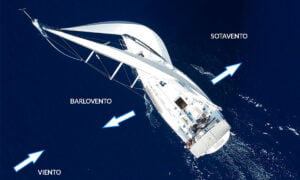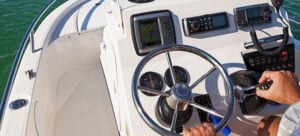One of the most important aspects in nautical is the wind. When we are sailing it is essential to know issues such as the intensity, the trend and, above all, the direction of this weather phenomenon. To identify this last factor, each point of origin is given a name, so all the winds of the Mediterranean can be easily defined.
And one of the advantages of this environment is that the trends and directions of the wind are relatively predictable, which helps us understand the weather and take advantage of it to determine the most appropriate navigation plans at all times.. That is why It is important to know the winds of the Mediterranean Sea that blow most frequently on the coasts of countries such as Spain, Türkiye, Greece, Italy or Croatia.
Get to know our Sailing course for all levels
Main winds of the Mediterranean Sea
Based on this possibility of predicting the weather conditions and circumstances when sailing, In the following list we show you the 10 winds of the Mediterranean Sea that we sailors encounter on a regular basis. This way, you can learn to identify them and differentiate them from each other when necessary.
Sirocco
Sirocco is one of the Mediterranean winds that reaches the highest intensity on the high seas, and can reach gusts of between 40 and 50 knots. Its origin is in the southeastern Mediterranean and sometimes reaches hurricane status in northern Africa, in addition to creating situations of low visibility on the coasts.
West
The west wind has its origin in the Atlantic Ocean, where it circulates with much more intensity than in the Mediterranean Sea, which is why it is sometimes called the Gale wind. It has a very particular characteristic that consists of a decrease in humidity and an increase in temperature as it progresses.
Mistral
The Mistral, one of the winds best known to sailors in this sea, originates in the northwest of the Mediterranean. and characterized by its turbulence, dryness and low temperature. And its gusts can reach up to 140 km per hour, with a usual duration of between 3 and 6 days and an approximate period of appearance between the months of November and April.
Marin
The Marín is another wind from the Mediterranean that tends to generate visibility problems, since, as it originates in the sea, it carries a lot of fog and humidity, which also causes it to generate precipitation when it reaches land. It comes from the southwestern Mediterranean and is usually much weaker on the coast than in open waters.
bora
This wind is one of the most frequent in Mediterranean winters and is characterized by blowing in gusts and by its low temperature and great dryness. It originates on the coasts of Italy, Croatia, Slovenia, Turkey and Greece, the area that makes up the Adriatic Sea, in the north and northeast of the Mediterranean Sea.
Meltemi
Between the months of May and September, the Meltemi wind blows frequently, which is felt intensely on the Greek coasts.. It is strong and dry, and its danger is explained by its low probability of prediction, since it is accompanied by clear skies and without prior warning and even reaches a strength of 7-8 on the Beaufort scale.
Tramuntana
One of the best known and most common winds on the coasts of the Mediterranean Sea, The Tramuntana wind comes strongly from the north and northwest from the sea. With gusts of up to 200 kilometers per hour, it can be dangerous when sailing, especially in the maritime area of Catalonia and the Balearic Islands, where it blows more strongly and can last for several days.
I raised
The Levante wind is especially known in the area of Spain named after it, again made up of Catalonia, the Balearic Islands and the Valencian Community. Its origin is located in the central Mediterranean area and is hot, dry and dangerous for navigation., to the point of causing cancellations of departures in numerous ports in Spain and Morocco.
Garbi
Also known as Lebeche, Libeccio or Lebic, The Garbí is a common wind in the stage that includes spring and summer and appears in the Mediterranean as a consequence of the thermal differences between land and sea. It originates in the desert and brings dryness and warmth to the southeast of Spain, generally accompanied by sand and dust -commonly known as Calima-.
Gregal
Finally, The Gregal is a wind from the Mediterranean Sea originating in the northeast and with great impact on the coasts of the islands of Sicily, Malta and, above all, in the Balearic Islands. It is usually accompanied by swells and strong waves, it is cold and dry and coincides with large storms in the Algeria area.
Are you interested in: Nautical Charts: What they are and why they are important
Why know the winds of the Mediterranean Sea?
As in most areas, information is power. Knowing the winds of the Mediterranean Sea in detail allows us to predict them, understand their behavior and danger., and plan outings based on these issues. Therefore, learning to identify these 10 most common types of wind in this area will make it easier for you to navigate with more safety and peace of mind.





